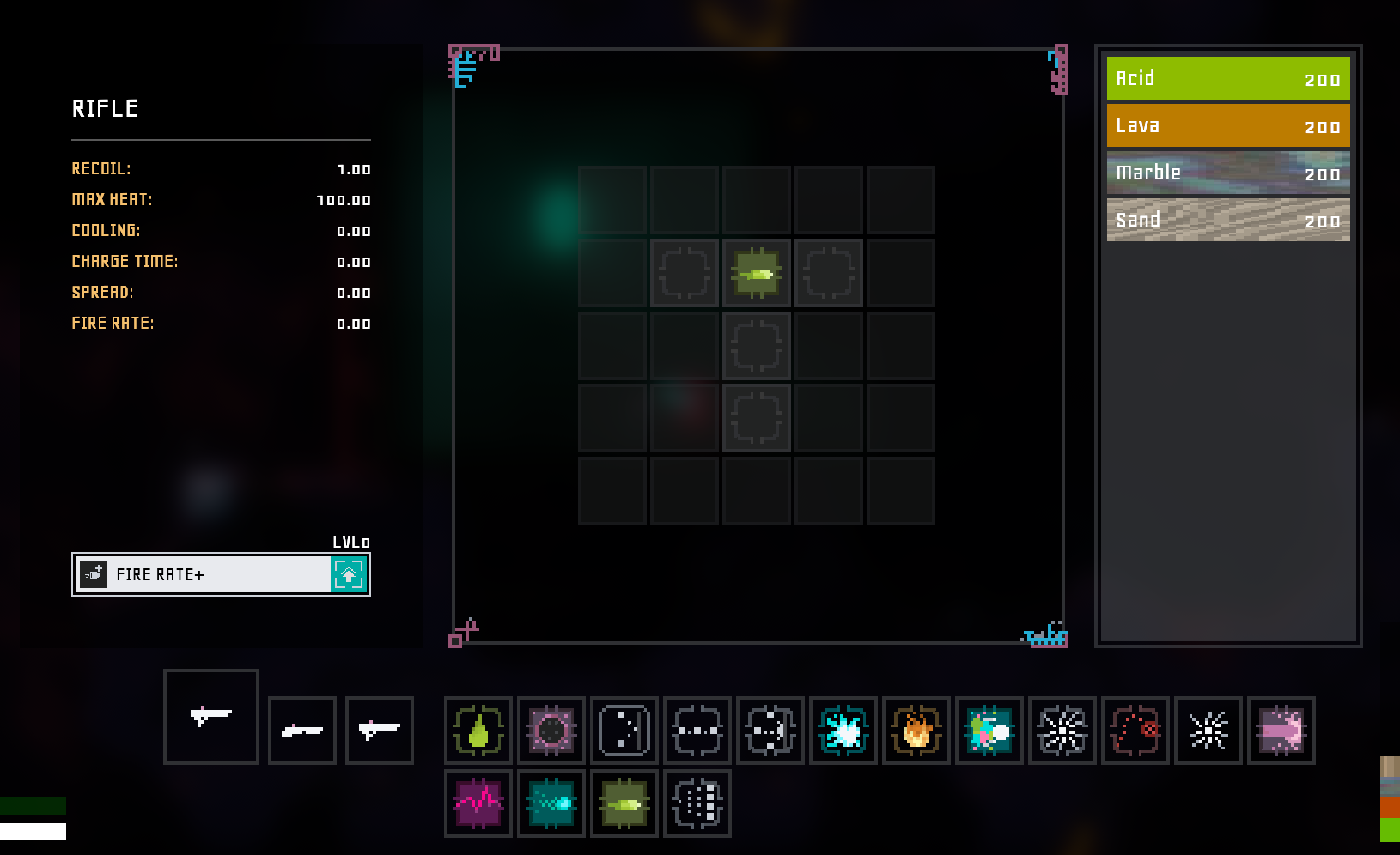In this post we’ll discuss a little bit deeper on what core concepts and systems the first iteration of the game will have. Note that many, if not all, things discussed in this post are still subject to change! If you have any ideas or thoughts, we are happy to receive any feedback in our Discord!
At this point we are getting closer to starting our first playtests so it’s also a good time to list a few facts about the game. The game will have roguelike and roguelite elements like permadeath, engine building (weapon/character builds) and a procedurally generated world. The extent of meta-progression we want to introduce is still under debate, but we think the game has some nice opportunities in that sense. Happy to hear thoughts and preferences regarding that.
The world will be a scifi-themed world and draws inspiration from cyberpunk and magepunk. It will most likely be a non-linear open world similar to Noita. Also I want to mention that “Quantum Corp” will likely not end up being the actual name of the game, but we can use that until the game is revealed!
Materials and staining
Materials (sand, steel, lava, fire and other elements) will play a large role in this game. We can define materials by giving them properties such as density, temperature, solid/gas/liquid state and electric conductivity to name a few! In addition, we can program materials to act in unique ways, for example make it homing towards the player or make it “breathe” by inflating and deflating it on a timer. We can somewhat turn them into living materials and have them act intelligently!
The green video has a thermal effect enabled which shows the temperature of each pixel when melting steel.
Another noteworthy thing to mention is that single pixels of solid material, like steel, will crumble and gain sand-like characteristics. This makes navigating the world a bit nicer because there shouldn’t be single pixels invisible to the human eye blocking any movement.
We’ll likely have a staining system similar to Noita where touching a material may stain you from 0-100%, depending how submerged you are.
Here you can see fire being extinguished after jumping in a pool of water. The stains themselves then will cause various status effects, as well as light the player on fire if the temperature is too high!
Collecting and using material
The special part of our game engine are the unique materials and their interactions with each other, and we really really want to leverage that in the gameplay. The idea that you can collect material from the world and use it in various ways has been at the core of our game for a long while already. Basically, any sand, liquid, crumble that is not solid and moves can be collected with a vacuum cleaner -kind of a contraption.
One purpose of all material is to act as a currency, some materials being more valuable to one shopkeeper, other materials valuable to another. Traditional shops may value gold, but others value something else. Materials can also be used to open chests or other types of locks.
An overarching concept in the game is the Quantum Corp, a company faction which the player can interact with. The player can earn rewards and gain rank within the company for depositing materials. Think of a lightweight version of the game Lethal Company (and to clarify, this game will not be an extraction shooter/looter game).
Another way to use material is for upgrading weapons. A weapon may have 0, 1 or 2 upgrade properties which can be leveled up with varying amounts of material. For example, the requirement to raise the Fire Rate upgrade’s level to 2 could be 50 Lava and 30 Sand.
Generally we want to stay away from base building. Some other ideas in mind that are still unexplored:
- using material as fuel/power for weapons
- using material to craft parts to weapons (in late game)
Weapon system
Like most roguelikes, this game will also have a modular / progressive way to power up your character. The main way to power up is by building your weapon. All weapons are composed of
- the weapon and its attributes
- a power core that is a vessel for all sorts of parts
- weapon upgrades

This is the main inventory of the player. On the left you can see the weapon, its stats and upgrades. The center part is the power core with a “projectile chip” in it, which defines what kind of projectile is shot. The bottom part has your weapons and backpack. And finally on the right it’s your material inventory where you can see all the material you have collected.
Weapon stats define how the weapon shoots, be it fast like a machine gun or slow and charged like a cannon. Weapons also have a cooling attribute to prevent overheating the weapon.
The power core on the other hand defines what is being shot. To build your weapon, you place parts into the power core, which comes in various shapes and sizes. Parts generate different amounts of heat and will overheat your weapon if not paid attention to. Parts include:
- projectile chips, which define the projectile’s main characteristics. For example, is the projectile a continuous laser or a single shot that explodes?
- modifiers, that can alter the projectile’s behaviour. For example, add a homing modifier or make the weapon shoot 4 bullets instead of 1.
- “beacons” (name to be defined), which can boost different parts of the grid around the beacon. For example, reduce the heat generation of all parts within the vicinity of this beacon.
- extensions, which can extend the current projectile. For example, spawn another projectile on hit.
A demonstration of how a “beacon” would boost all parts in an area
Weapons are not limited strictly to traditional weapons! They also include gadgets and other devices like turrets, grenades, and perhaps a drone companion, which all carry a power core.
Last but not least, weapons can have upgrades which can be leveled up in exchange for some material collected from the world. These are more like secondary benefits, for example a minor fire rate bonus or gain movement speed on every kill for X amount of time.
When you fire a weapon, all parts in the power core will activate to generate projectiles, unless it overheats. The trick to build powerful weapons is being clever in placing parts into the grid.
So one weapon composes of quite a bit of things. There is definitely a challenge to make all this cohesive and intuitive while making it deep enough to be interesting.
Waypoints and a map system
A design challenge that has been bothering me for quite some time is how to intuitively offer the player a direction? We are a little bit hesitant to make the main direction go downwards in order to differentiate us from Noita. Although, the more I work on this game the more I understand why the direction being downwards is generally a good idea in falling sand games. You can always get down. Going down is easy. Getting softlocked due to destroyed terrain is hard when going downwards etc.
An idea we’re experimenting with is having a map which contains points of interest to guide the player. They are landmarks for the player to travel to, in order to complete their objectives. Some of these landmarks are waypoints, which can be used to fast travel between other waypoints once discovered. This would reduce the amount of backtracking required if the way forward is not linear.
That’s all for this post. Let us know your thoughts in our Discord!
